Medium- to high grade metamorphic rocks, Ballachulish Igneous Complex - an excursion
From: Pattison, D R M and Harte, B. Ballachulish Igneous Complex and aureole: a field guide Edinburgh : Edinburgh Geological Society, 2001.
Medium- to high-grade into bedded pelitic and calsilicate hornfelses and marbles; various migmatites, including 'chocolate-tablet' type; summit(s) of Beinn a' Bheithir.

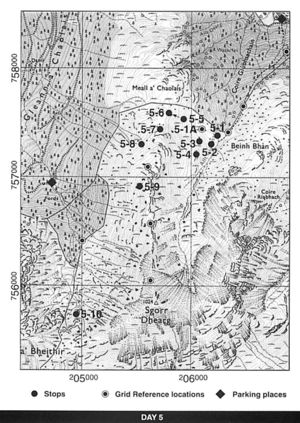
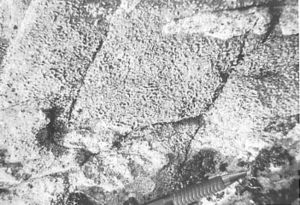
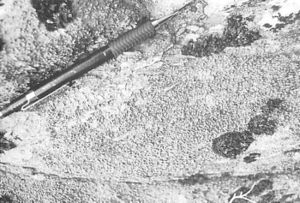

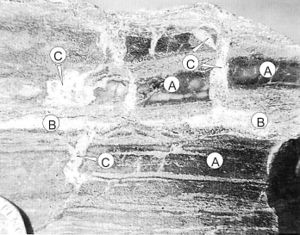

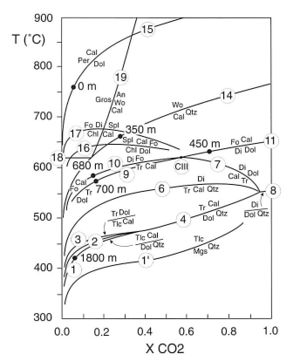

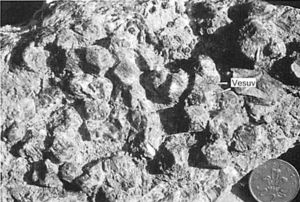
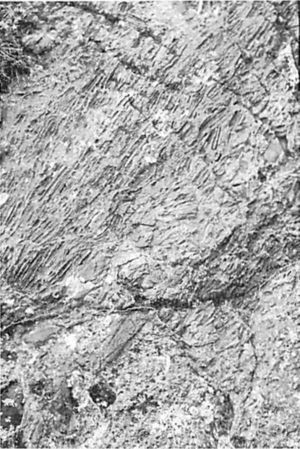

| Stops | Grid ref.(sheet NN) | Features |
| Stop 5-1 Allt Giubhsachain | NN 0625 5740 | Interbedded dolostone, limestone and quartzite |
| Optional Stop 5-1A | NN 0615 5745 | Siliceous carbonate exposures containing isobaric invariant assemblage cal+dol+tr+di+fo |
| Stop 5-2 | NN 0615 5730 | Interbedded pelitic and semipelitic Hornfels, Zone IVb) |
| Stop 5-3 | NN 0605 5731 | Muscovite + Qtr = Andalusite + K-feldspar (Zone IV/V) isograd |
| Stop 5-4 | NN 0605 5720 | Spectacular massive cordierite + K‑Feldspar ± andalusite hornfelses, Zone V |
| Stop 5-5 | NN 0590 5750 | Corundum-bearing hornfelses, Zone Vb |
| Stop 5-6 Ridge top | NN 0590 575 to to NN 0575 5755 | Increasing range and intensity of migmatitic features going upgrade |
| Stop 5-7 | NN 0570 5745 | Veined calcite+dolomite+spinel+Forsterite (serpentine) marbles |
| Stop 5-8 | NN 0555 5730 | Periclase-bearing marble outcrops surrounded by leucogranite |
| Stop 5-9 | NN 0555 5690 | Layered, grossular+vesuvianite-rich calc‑silicates |
| Stop 5-10 | NN 0495 5575 to NN 0485 5545 | Spectacular 'chocolate tablet' migmatites and xenolith-rich quartz diorite |
This is a strenuous day with a tough beginning, but if the weather is fine go for it, because it provides excellent exposures of a rich variety of rock types in the NE sector of the aureole in and around Coire Giubhsachain. Several isograds can be mapped in these rocks (see Coloured Map). This is also the only area where there is a continuous exposures of carbonate and calsilicate rocks covering a range of grade in the aureole. The carbonate/calsilicate rocks are interbedded with pelitic and semipelitic hornfelses. many corundum-bearing, which show beautifully preserved subsolidus and migmatitic textures. The location of the Ms+Qtz = Kfs+And isograd can be tightly located. At the end of the day. there are many possible options, including examination of impressive 'chocolate-tablet' migmatites and ascent of either or both of the summits of Beinn a' Bheithir.
The itinerary starts from the main road (A82) and involves a walking traverse through exposures around Coire Giubhsachain, along the Wall a' Chaolais to Sgorr Dhearg ridge, and on the western flank of Sgorr Dhearg. There is 610 km of walking and 700-1000 m of elevation gain, depending on the options taken. Locations are given on the geological and topographic maps of Fig. 13.
Note: It is not necessary to drive along the forestry roads/tracks on this excursion, unless you wish to use a second vehicle and leave it within the forest at a potential end point for the excursion. Use of a second vehicle is particularly convenient if you wish to do option (c) at the end of the day and examine the 'chocolate-tablet' migmatites. In this case, using two vehicles will save ca. 5 km of walking at the end of the day. However, as usual, use of the forestry roads necessitates having a key to the Forestry gates (see section on Logistics for Field Excursions). If used, the second vehicle should be left by the forestry road in Gleann a'Chaolais at NN 0470 5695 (refer to the 1:25,000 OS map for navigation, and the notes for entering the forest under Stop 1-5).
Directions to start of Day 5 traverse: From the junction of the A82 and the A828 at a roundabout (NN 0570 5930) 0.5km southeast of Ballachulish Bridge, take the A82 road east towards Ballachulish for about 1 mile (1.6 km) until St. John's Church is reached. Along the route, there are several large exposures of regional garnet-bearing semipelitic schists with a contact metamorphic overprint: unfortunately, the rocks are rather fine-grained and altered, and make disappointing viewing for such extensive exposures near the igneous contact. Park the vehicle in the parking area around the gate (NN 0680 5845) giving access to the cemetery and church. Set the altimeter to 10m.
Looking southwards, uphill from the vicinity of the church gate, you are going to proceed by foot up the bluff and ridge immediately before you. This is a moderately steep uphill walk for about 0.4 km with an elevation gain of about 160 m, but then proceeds more gently uphill through the forest to give you access to the upper part of Allt Giubhsachain and Coire Giubhsachain.
From the church gate, go to the forestry gate about 50m to the SE, and enter the forest by the style besides this gate. You follow the forest road/track from the gate for only about 10 m before turning left on to the start of a small footpath which will carry on (in zigzags) up the steep bluff to the south. This path (as of 1999) looks as if it will probably fade out after a few tens of metres, but have faith, it does carry on all the way to reach Allt Giubhsachain.
Walk steeply upwards along the path, which has some zig-zags and can be ill-defined in places, but dominantly heads southwards (Fig. 13b) for 0.3 km, until you reach a point (NN 0680 5820) where you are about 30m below a deer fence. This fence runs across the hillside in a dominantly NE-SW orientation (the fence may or may not be visible from the path, depending on the forest cover). At this point the path becomes less steep and runs subparallel to the fence in a SW direction. After about 500m you pass from pine forest (as of 1999) to thinner birch and pine woodland. As birch becomes the dominant tree the deer fence becomes visible and you carry on along the path to cross the fence very obliquely by a style at about NN 0645 5765. In this area there are many boulders of Appin Quartzite, some of which show excellent cross-bedding. Again you continue along the path subparallel to the fence, with little change of' height until NN 0635 5740. Here the fence turns 90° to head steeply downhill to the NW, while the path carries on to the SW and takes you more gently to the Allt Guibhsachain burn (stream) at about NN 0625 5735, elevation 360m. A good overview of Coire Giubhsachain is obtained just before descending to the stream.
Note: An alternative route into Coire Giuhhsachain which is less direct but more scenic is to park in the town of Ballachulish and ascend the east flank of Beinn Bhan. either going over the top of the ridge or skirting around its northern nose, and dropping clown into Coire Giuhhsachain along numerous sheep paths.
Overview of Coire Giubluachain. A good overview of Coire Giuhhsachain is obtained from the path near NN 0635 5740, just before it descends to the Allt Giuhhsachain burn. Looking SW across the stream valley, the foreground is a large rounded, rocky knoll of interbedded semipelite, psammite and petite of the Appin Phyllite unit. These rocks are folded into a tight SW-plunging anti form whose hinge runs through the middle of the knoll; this antiform is at the core of a larger synclinorial W-fold, which forms the steeply SW-plunging, Coire Giubhsachain syncline (Figs. 2 and 13).
Looking SW-SSW above and behind the rocky knoll, the rocky ridge top consists mainly of abundant medium- to dark-grey layered semipelitic rocks, with some prominent layers lower down the slope bending around into the core of the syncline. Further up the ridge top to the SSW (bearing ca. 215°) is a prominent white exposure adjacent to exposure-poor grassy slopes; this is Appin Quartzite in fault contact with interlayered carbonate and metapelitic hornfels layers. This post-intrusion fault is probably the same fault that runs through Allt Giuhhsachain (see below). From the prominent white exposure on the ridge top, Appin Quartzite persists up to the summit of Sgorr Dhearg (bearing ca. 200°).
Turning to the WSW (right of the rounded knoll in the foreground), lush grassy slopes occur in between ribbed exposures whose layering trends subvertically uphill. The grassy slopes are underlain by carbonate-rich rocks of the Appin Limestone unit, whereas the ribbed rock is interlayered psammite and pelitic/semipelitic hornfels of the Appin Phyllite unit: these features showing the intimate relations of the two lithologies. The ridge top above here coincides closely with the igneous contact: rounded light coloured exposures visible in a few places on the ridge top are apophyses of leucocratic quartz diorite.
Looking to the left (east) of Allt Giubhsachain (approximately S-SSE), the white outcrops on the west flank of Beinn Bhan and up to the un-named peak to the east of Sgorr Dhearg consist largely of Appin Quartzite. The Allt Giubhsachain fault thus separates largely quartzite to the east of the viewpoint, from interbedded pelite, semipelite, psammite, carbonate and calsilicate to the west of the viewpoint (see Coloured Map and Fig. 13). In some locations in Allt Giubhsachain stream bed (e.g., around NN 0620 5720), prominent fault gouge is seen.
Stop 5-1. Interbedded dolostone, limestone and quartzite. NN 0625 5740, 340m.
Directions: From where the path meets the burn, descend the burn to where a fence crosses the burn. The exposures in the burn here comprise Stop 5-1.
Description: The rocks are well-layered, with individual layers consisting of: cream-coloured dolostone with siliceous interbeds (showing small-scale boudin structure); white quartzite (locally cross-bedded); and less common impure limestone. These rocks comprise the Appin Limestone unit. Dolomitic layers contain combinations of tremolite (Tr), forsterite (Fo), calcite (Cal) and sometimes chlorite and phogopitic biotite, whereas impure limestone layers contain combinations of Tr, Cal, quartz (Qtz) and diopside (Di). These assemblages place the rocks by isograds C6 (Tr + Cal + Qtz = Di + CO2 + H2O) and C9 (Dol + Tr = Fo + Cal + CO2+ H2O) (Masch & Heuss-Aßbichler, 1991) (see Figs. 5 and 6). Combined with calcite-dolomite geothermometry, these assemblages imply temperatures near to 600 °C.
The exposure occurs in the vicinity of the fold hinge oldie steeply SW-plunging syncline in Coire Giuhhsachain. The orientation of layering dips about 50° SW. In quartzite layers, there is a steeply dipping, spaced cleavage striking about 045°, approximately axial planar to the syncline.
Optional Stop 5-1A: Carbonate exposures containing isobaric invariant assemblage calcite+dolomite+tremolite+diopside+forsterite. NN 0615 5745; 380m.
From Stop 5-1. follow the fence ca. 150 m up the slope to the WNW to some grassy slopes where low exposures of variably tilted slabs of veined carbonate are encountered. Some of these contain all five minerals associated with the isobaric invariant assemblage Cal+Dol+Tr+Fo+Di (CIII. Fig 6), although the fine grain size of the rock prevents identification of the whole assemblage in the field. The silicate minerals occur most abundantly in the veins. This assemblage (see Figs 5 and 6) implies temperatures of about 620 °C (March Eleuss-Assbichler, 1991: Ferry. 1996a). Other exposures containing the same assemblage are found about 100m to the south and west in low exposures by some alder trees.
Stop 5-2. Interbedded pelitic and semipelitie hornfels, Zone IVh. NN 0615 57311, 400m.
Directions: This Stop is a low, gently-sloping exposure surrounded by heather. It is located on a bearing of 210° uphill from Stop 5-1 and lies to the east of the main exposure face of the corrie, and about 30 m down the slope and to the right (NW) of a prominent large dark angular boulder of layered pelitic and semi pelitic hornfels.
Description: The rocks consist of interlayered psammite, semi pelite and rare Ms-rich metapelite. The layering strikes east-west and is sub-vertical. Primary sedimentary features in the quartzite and semipelite include graded bedding and cross-bedding, with the way up direction W towards the core of the syncline. The semipelitic layers are massive pitted hornfelses rich in cordierite and K- feldspar in addition to biotite and sometimes muscovite, and are characteristic of Zone IVb (ca. 620 °C). The light-coloured Kfs-rich ribbed or mesh network around cordierite crystals seen elsewhere in the aureole is well developed (see Photo 12). In some places, the ovoid cordierite crystals have weathered down relative to the matrix, whereas in other places they appear to weather up, the latter most likely due to a rind of relatively resistant K-feldspar mantling the cordierite. Rare thin, light coloured layers in between semipelitic layers are rich in muscovite. These layers may represent the low grade equivalents of andalusite- and corundum-rich layers seen at higher grade.
Stop 5-3. Muscovite + Quartz = Andalusite + ti-feldspar (Zone IV/V) isograd. NN 0605 5730. 450m.
Directions: From Stop 5-2, bear west for about 150 m climbing up the rock-and heather-covered slope, keeping to the down-slope, or south-facing side of the main exposure. Along the route, a subsidiary synclinal hinge zone of the Coire Giubhsachain syncline is crossed. The approximate hinge zone is seen in the first main exposure past Stop 5-2, where wiggly bedding has an overall orientation of about 330° with a steep SW dip (compare with bedding orientation of Stop 5-2), and cleavage has an orientation of about 045°/90°, similar to the orientation of cleavage at Stop 5-1. The next exposure, ca. 50 m away, is on the other side of the fold, as revealed by bedding with an orientation of 210°/65° E. Continue ascending the slope, examining interlayered rocks with numerous cm-m scale folds. Stop 5-3 is at the highest point of the heather covered slope beneath the steeply sloping rock face, by some small alder bushes.
Description: The rocks comprise semipelite, pelite and psammite interlayered on cm-scale. If one looks carefully, some thin pelitic layers in between thicker psammitic and Crd-pitted semipelitic layers show a finely-developed ribbed texture from which protrude <1 mm wide pointed crystals (perpendicular to layering) or within which lie slender <10 mm long prismatic crystals (parallel to layering) (sec Photo 18). These are andalusite crystals. The addition of andalusite to the Ms+Crd+Bt+Kfs+Qtz assemblage at Stop 5-2 places these rocks in Zone V. The continuing presence of muscovite in these layers places the rocks near the Zone IV/V isograd, corresponding to the reaction Ms+Qtz = And+Kfs+ H2O (640 °C).
The Zone IV/V isograd, defined by the first appearance of And+Kls, can be very tightly located (to within less than 20 in) in this vicinity. Stop 5-3 is the first visible occurrence of andalusite in field exposure, but andalusite has been observed in thin section about 20m downslope and to the east. The thin layers containing andalusite may correspond to the thin Ms-rich layers seen at Stop 5-2.
Sillimanite first occurs sporadically at or slightly upgrade of the And+Kfs isograd in this vicinity. When present, it is typically in very small modal abundance and very fine grained, often showing a spatial association with cordierite poikiloblasts (Paulson. 1992). Sillimanite is more abundantly present in pelitic layers in heather-covered exposures about 150m upslope to the SW, and at Stop 5-4.
Stop 5-4. Spectacular massive cordierite + K-feldspar ± andalusite hornfelses, Zone NN 0605 5715, 480m.
Directions: From Stop 5-3, follow around the rocky knoll to the west and then ascend a grassy gulley (bearing about 2000 uphill) to a level grassy area on top of the knoll. About 50-75m away downhill in a SE direction are some prominent grey exposures.
Description: The exposures arc made up of spectacular interlayered massive semipelitic and pelitic hornfelses with complex folding structural patterns, and pitted textures. The ribbed/meshwork texture of white K-feldspar-rich matrix surrounding cordierite crystals (represented by pits on the exposed surfaces) is especially well developed. The layers with the most prominent, whitest ribbing are pelitic layers containing the assemblage And+Kis+Cal+Ht+Qtz, with minor sillimanite (not visible in hand specimen) and muscovite ( probably late and retrograde). Greyer layers with less accented ribbing are semipelitic layers containing the assemblage Bt+Crd+Kfs+Qtz with late Ms. The dark exposures about 100m south of these exposures are of a small plug of mark: intrusive rock (kentallenite).
Stop 5-5. Corundum-hearing hornfelses, Zone Vb. NN 0590 5750, 470m.
Directions: From Stop 5-4, return to the top of the knoll and bear about 345° to the bottom of a dark ribbed outcrop surrounded by heather about 350m distant (Stop 5-5). The exposure is at the bottom of a slope with abundant exposures leading up to the ridge top. On the way one crosses grassy slopes with scattered carbonate/calsilicate exposures and an exposure of interlayered psammitic and semipelitic hornfels.
Description: The exposures around here contain interbedded semipelitic, psammitic and pelitic hornfels (see Photo 9). Pclitic hornfels layers show conspicuous I -2min wide, 5-15mm long andalusite crystals weathering upwards on clean exposure Surfaces, sometimes mantled with a thin rind or whitish K-feldspar (see Photo 18). Some andalusite-rich layers contain small <2mm light-coloured pimple-like features: these are corundum crystals surrounded by a halo of whitish K- feldspar (see Photo 19), indicating a temperature of about 670° C. Sillimanite is present in many layers, along with abundant Crd+Bt. In addition to the well-developed mesh network seen before, there are a few light coloured straight-walled veins present in the exposure. generally parallel to layering.
Stop 5-6. Increasing range and intensity of migmatitic features going upgrade. NN 0590 5750, 470m - NN 0575 5750, 590m.
Directions: From Stop 5-5, bear about 290° up the slope, following the orientation of layering and keeping to the good outcrop exposure. A prominent white quarts vein is visible part way up the slope. A short distance above this quartz vein, your easiest ascent is across a light coloured flattish surface (strike ca. 340°, dip ca. 40° NE), covered in places with scree and adjacent to upstanding ribbed exposures of interbedded psammite and pelitic hornfels. The light coloured flattish surface is a 1-2 cm wide vein of granite, containing muscovite and sometimes black tourmaline. that cuts the subvertical metasedimentary layering. This slope is steep with abundant loose rock in places, so care must be taken. Examine exposures going upgrade.
Description of Stop 5-6: The exposures going up the slope from Stop 5-5 strike into the igneous complex, the latter cropping out at the top of (lie ridge. This affords the opportunity to examine progressive changes in the extent and style of migmatisation as grade increases. At about 490-500m, subvertical quartzofeldspathic veins up to 4 mm wide and trending about 225° cut hornfels layers, generally terminating in quartzofeldspathic layers parallel to layering. Locally the light coloured, Kfs-rich mesh network in between cordierite crystals in semipelitic layers appears to become more continuous and seems to merge into smaller veins in a manner suggestive of segregation. In thin section, the Kfs-rich material shows a range of textures suggestive of the former presence of melt (Pattison & Harte, 1988: Harte et al., 1991a).
At about 510-520 m, near where a prominent, shallowly-dipping white quartz vein cuts the ribbed hornfelses, are many layers rich in andalusite and corundum. The density of thin quartzofeldspathic veining varies in this vicinity, and in semipelitic Crd+Kfs-rich hornfelses, the Kfs-rich meshwork appears locally flattened.
At about 560-570 m, from which the top of the ridge is visible, the exposures take on more of a brownish colour. There is a greater density of quartzofeldspathic veins (Photos 20 and 21), and the rocks locally appear more twisted and distorted, although the primary layering is still obvious.
Compared to lower down the slope, the rocks at heights around 560-570 in, and extending up onto the ridge top, show an increasing number of discontinuous quartzofelspathic veins. These veins are cms or dms in length with varying orientations, which locally transect several layers hut which are not generally completely cross-cutting, and through-going. Pelitic layers may be broken (boudinage-like structure) and cross-cut by quartzofeldspathic (leucocratic) material, while semipelitic layers remain more continuous and may show evidence of flowing between fragmented pelitic blocks (see Photos 20 and 21). In semipelitic layers, the Kfs-rich mesh network is variably flattened and deformed, whereas in pelitic layers, the mesh network appears relatively undeformed.
At 580-590 m, on the edge of the ridge plateau, are relatively more isolated exposures surrounded by grass showing a variety of the migmatitic features seen below. Some layers show cm-scale pull-apart boudin structures, consisting of dismembered layers of ribbed pelitic hornfels separated by granulose semipelitic material, sometimes with coarser quartzofeldspathic material occupying the gaps in between the pelitic hornfels fragments (see Photos 10. 21 and 25, and description and explanation of Stop 1-9). Andalusite-rich layers are common, some with corundum.
On the ridge plateau area are scattered exposures of high-grade hornfels showing a range of migmatitic features (similar to those described above; see also: Pattison & Harte. 1988: Harte et al., 1991a: Linklater et al., 1994). Light coloured exposures in the vicinity are apophyses of leucogranite of the igneous complex.
Stop 5-7. Veined calcite+dolomite+spinel+forsterite( serpentine) marbles. NN 0570 5745, 610m.
Directions: From the top of the rocky ridge by Stop 5-6, ascend the grassy ridge top to the south for about 100 m until some prominent grey-brown veined exposures arc encountered.
Description: The host rock to the veins is brown-grey weathering calcite +spinet( Sp1)+forsterite/serpentine-bearing dolomitic marble (see Photo 22). The veins are rich in calcite and forsterite, the latter commonly extensively altered to serpentine. Spinel likely formed front the reaction: chlorite + Dol = Spl + Fo + Cal + CO2 + H2O (reaction 16 in Figs. 5 and 6), which combined with calcite-dolomite thermometry indicates a temperature near 650 °C. An interesting additional minor phase in these rocks is baddeleyite (Bad; ZrO2), a mineral that is useful for age dating. Baddeleyite is thought to have been formed from reaction of zircon (presumably detrital) in the dolomitic host rock by the reaction: Zr + Dol = Bad + Cal + Fo + CO2 (Ferry, 1996b). The spinel and baddeleyite isograds are both poorly constrained but must occur between Stops 5-1 A and 5-7 (see also Fig.5). Down the slope to the west of these ridge-crest exposures are small exposures and boulders of leucogranite.
Stop 5-8. Periclase-bearing marble outcrops surrounded by leucogranite, NN 0555 5730, 630m.
Directions: From Stop 5-7, bear 225° across the NW-facing slope for 200 – 300 m, passing the edge of a scree-covered exposure, until some lush green mossy slopes are reached. Isolated green-brown marble exposures, sometimes in depressions, are found in between scattered low exposures of leucogranite over a distance of about 100m in a roughly SW trend.
Description: The layered marble locally shows minute black speckling. The black speckles are brucite pseudomorphs after periclase (Per). In only one sample has fresh periclase been found. The full assemblage is Per+Fo+Spl+Cal+Dol. with forsterite partially replaced by serpentine (Masch & Heuss-Aßbichler, 1991). The reaction (C15) inferred to have formed periclase is: Dol = Per + Cal + CO2 (reaction 15 in Figs. 5 and 6). This is the highest grade marble assemblage in the aureole (see Fig. 5), with calcite-dolomite thermometry indicating a temperature of 760 C. The formation of periclase at these relatively low temperatures implies that the reaction was driven by the infiltration of water-rich fluids (Ferry, 1996a; Pattison & Harte, 1997).
Stop 5-9. Layered grossular+vesuvianite-rich calsilicates. NN 0555 5690, 720-750m.
Directions: From Stop 5-8, hear east uphill back to the to the ridge crest, examining brown-weathering exposures of veined and locally disrupted migmatites interlayered with some calsilicate, and locally cut by apophyses of leucogranite. Then continue up the ridge crest to the SSW, noting a late hornblende- and plagioclase-phyric andesite dyke, and a number of exposures of fine-grained granite in a fairly level part of the ridge top (NN 0560 5710: 700 m: location marked on Fig. 13b). From here, you should aim to get to exposures (Stop 5-9) about 200 m to the SSW. These exposures are on the fairly steep W-facing slope of the ridge, and have a platy aspect with abundant scree beneath. Proceed, either directly to the SSW going obliquely uphill for about 200 m, or, alternatively ascend the ridge crest southwards to an elevation of about 760 m (NN 0560 5690), and then hear west down the slope.
Description: The rocks consist of interlayered calsilicate, marble, psammite and less commonly pelite, sometimes in highly contorted layers with abundant tight small-scale folds. Especially striking are layered calcsilicates with coarse grossular crystals confined to discrete layers (see Photo 23). Grossular varies in colour from light to medium brown (due in part to varying andradite component), sometimes occurring in crystals the size of golf balls. Vesuvianite (idocrase) is common in the grossular-bearing layers, occurring in 5-20mm long medium- to dark-brown prismatic crystals. Assemblages in these rocks vary from layer to layer, but include combinations of grossular, vesuvianite, epidote, diopside, wollastonite, calcite, quartz, scapolite, amphibole, prehnite, phlogopite, muscovite, K-feldspar, chlorite and plagioclase (not all in equilibrium). Most of the minerals cannot be identified in the field. Temperature estimates for these rocks are ca. 700 °C, and they indicate equilibration with water-rich fluids (Paulson. 1985).
Stop 5-10. Chocolate tablet migmatites and xenolith-rich quartz diorite. NN 0495 5575, 650m - NN 0485 5545, 770m.
Directions: Stop 5-10 comprises an elongate series of exposures which trend NNE down the slope from the bealach (pass or col) between Sgorr Dhearg and Sgorr Dhonuill. Two possible routes to Stop 5-10 from Stop 5-9 are:
(1) Sgorr Dhearg route. This involves returning to the ridge crest by heading, eastwards, and then ascending southwards along the ridge crest to the summit of Sgorr Dhearg, from which there are spectacular views. Points of geological interest en route include: the abrupt appearance of Appin Quartzite (at NN 0560 5660, 830 m; marked on Fig. 13), which is separated from ribbed marbles and semipelitic hornfelses to the south by a late strike-slip fault (probably the same fault that goes through Allt Giubhsachain); (ii) small bodies of mafic intrusive rock (kentallenite) situated near a flat part of the ridge at NN 0565 5605. 960 m.
The summit of Sgorr Dhearg is underlain by Appin Quartzite. From the summit, descend the ridge to the WSW towards the bealach between Sgorr Dhearg and Sgorr Dhonuill, reaching the top of the series of exposures of Stop 5-10 a little before the low point of the bealach is reached.
(2) Igneous contact route. This involves traversing across the NW-facing flank of Sgorr Dhearg, and you may examine en route the complex geology in the contact zone of the igneous complex (see Fig. 13 for both geology and topography). The country rocks include semi pelitic/pelitic hornfels and grossular- and wollastonite-bearing marbles, whilst the igneous complex is represented by marginal quartz, diorite and granite.
Description of Stop 5-10: These exposures represent a screen of interbedded pelitic and semipelitic country rock occurring between granite to the east and monzodiorite to the west. The best exposures are W-facing surfaces relatively near the bottom of' the slope, at an elevation of about 650 m (NN 0495 5575).
The name 'chocolate-tablet migmatite' is used to describe many of these rocks because of the way in which individual nun-cm scale layers of cordierite-rich hornfels and psammite are broken into sharp-margined, often rectilinear, tablet-shaped fragments (see Photos 24 and 25). The mobile material in between the brittle fragments is rich in Kfs+Qtz with variable amounts of plagioclase. In many places, the overall continuity of layering is preserved even when individual layers have been pulled apart into numerous fragments. In other places, the amount of mobile material has resulted in disaggregation of the hornfels and psammite fragments so that the overall continuity of layering is lost; this phenomenon is seen most clearly at the margins of the screen, where disaggregated pelitic and semipelitic hornfels fragments are frozen in the process of being broken off, carried away and partly digested by the magma of the intrusive complex.
The relatively extensive exposures of 'chocolate-tablet' migmatite are special to this locality, but the overall migmatitic features seen here recall those seen elsewhere in the aureole (e.g. Stops 1-9, 4-9 and 5-6 and Photos 1(1 and 21). The breaking apart of the Al-rich hornfels layers is thought to result from overall expansion of the rocks on melting. Note how the kfs+Qtz-rich leucosome, filling the gaps between the rectilinear cordierite-rich hornfels fragments, tends to merge into the enclosing semipelite rather than cross-cut it. Thus these leucosomes do not form continuous cross-cutting veins, and are believed to have largely derived their material (initially as melt) from the semi-pelite.
The local variations between overall preservation of primary layering and complete loss of layering are interpreted as being due to differences in the amount of melt in the rocks. Where the amount of melt exceeded the critical melt fraction, the mixture of melt + crystals ± hornfels fragments behaved as a suspension and flowed, resulting in disruption and disaggregation of preexisting layering and sometimes leading to xenolith-choked dyke-like bodies. In rocks in which the critical melt fraction was not exceeded, small-scale disruption and segregation of leucosome occurred without loss of the overall pre-existing layering. Even where the layering is well preserved, the small-scale ductility of thin semipelitic layers suggests that the melt fraction within these particular lavers was high enough to allow internal deformation and flow.
In an overall sense, the extent of migmatitic disruption is greater than seen earlier in the day (Stop 5-6) and on Day 3, Part 1 (Fraochaidh ) and Day 4, but less than seen in the Chaotic Zone of Day 3, Part 2. A special feature of the Stop 5-10 exposures, compared to others seen elsewhere in the aureole, is the more obvious involvement of magma from the intrusion in the disaggregation process, particularly in the marginal zones of the outcrops.
High grade assemblages are present in these rocks. Quartz-bearing layers locally contain garnet in addition to Crd+Bt+Kfs+Pl+Qtz, whereas quartz-absent layers contain Crd+Sil±And±Crn±Spl. Spinel is common in the rectilinear hornfels fragments, visible as minute (<1 mm) dark crystals in the cordierite-rich rock. Geothermometry estimates for these rocks indicate about 750-800 °C Pattison & Harte, 1997).
Options from Stop 5-10.
(a) Descend the N-facing valley from Stop 5-10, eventually joining a rough track by a N-trending fence. Follow the fence down to ca. NN 0500 5645 (marked on 13), and then follow one of the streams heading down to the NW. All these streams lead to the forestry road/track by NN 0470 5695 in Gleann a'Chaolais, where you may have left a second vehicle (see initial directions for Day 5). If you have not used a second vehicle, walk along the forestry roads back to St. John's Church (ca. 5 km of walking; refer to the 1:25.000 OS map to navigate along the forestry roads/tracks).
(b) Retrace the route back to St. John's Church, via the slopes of Sgorr Dhearg. A scenic option is to go back over the summit of Sgorr Dhearg and over the unnamed hill to the east of Sgorr Dhearg, and descend to Beinn Bhan. From here, simple descents may be made: either into Coire Giubhsachain, where the path through the forest taken at the start of the day can be joined, or down to the village of Ballachulish.
Note: If it is desired to visit locality 5-10 by itself, the most direct route is to use the forestry road in Gleann a'Chaolais to get to NN 0470 5695, and then climb up the valley to Stop 5-10, reversing the route described under (a) above. Remember that to drive into Gleann a'Chaolais it will be necessary to have a key to the Forestry gates (see section on Logistics for Field Excursions).
Photo 18 (opposite. above). Stops 5-3 to 5-6. 1-8 and 3-5. Randomly orientated andalusite prisms in a massive cordierite+K-feldspar-rich pelitic hornfels (Zone V). The photograph was taken at Stop 5-5.
Photo 19 (opposite, below). Stops 5-5, 1-8 and 3-5. Corundum-rich, quartz-absent pelitic hornfels of Zone Vb. The corundum is risible as abundant small, rounded 'pimples' that contrast with the more prismatic andalusite crystals seen below the pencil (compare with Photo IS).
Photo 20 (opposite, above). Stop 5-6.
Anastomising veins rich in K-feldspar + quartz, within layered cordierite+K-Feldspar-rich pelitic and semipelitic hornfels. The prominent light coloured vein (lower left of photograph) is of granitic material from the igneous complex. See notes of Stop 5-6 (above 560 m) and Stop 1-9 for a fuller description and explanation al the veins and other features. From the ridge/plateau area around Stop 5-6.
Photo 21 (opposite, below). Stop 5-6. Detail of migmatitic rocks with boudin-type structures. The original lithology was of interlayered pelitic and semipelitic material and now shows rigid, pulled apart cordierite-rich hornfels (metapelite) layers (A), ductile semipelitic layers (B) and segregated Kfs+Qtz-rich leucosomes occupying the gaps between the pulled apart hornfels layers (C). Notice how the leucosome merges into the ductile semipelite, giving the impression of being extracted from it. Field of view is 5 cm across. See notes of Stop 1-9 for further explanation.
Photo 22 (opposite, above). Stops-7. Calcite+spinel (Spl )+Forsterite-bearing dolomitic marble with folded veins of calcite and forsterite. The Forsterite is commonly, extensively altered to serpentine giving the veins a yellow-brown colour on the weathered exposure surface.
Photo 23 (opposite, below). Stop 5-9. Calsilicate rock rich in grossular (equant crystals) and vesuvianite ( indicated 'vesuv').
Photo 24 (opposite, above). Stop 5-10. 'Chocolate-tablet' migmatites. See the notes under Stop 5-10 far a description and explanation of the features visible in the top part of the photograph. Cutting across the bottom of the photograph is a lighter coloured dyke-like body of quartz-diorite, carrying many inclusions of pelitic hornfels; boundary picked out with white line.Photo 25 (opposite. below). Stop 5-10. Detail of 'chocolate-tablet' migmatite. The rock consists of interlayered petite and semipelite. Cordierite-rich hornfels lavers and broken into angular fragments in a tablet structure, with mobile leucocratic material both cross-cutting and running parallel to the layering. The mobile leucocratic material separating the hornfels fragments merges into semi-pelitic layers and does not form extensively cross-cutting veins. Compare with Photos 10 and 21.
Figure 13: (a) Geological map showing location of field stops for Day 5 (see Pg. 7 for key to geological map).
| At all times follow: The Scottish Access Codeand Code of conduct for geological field work |